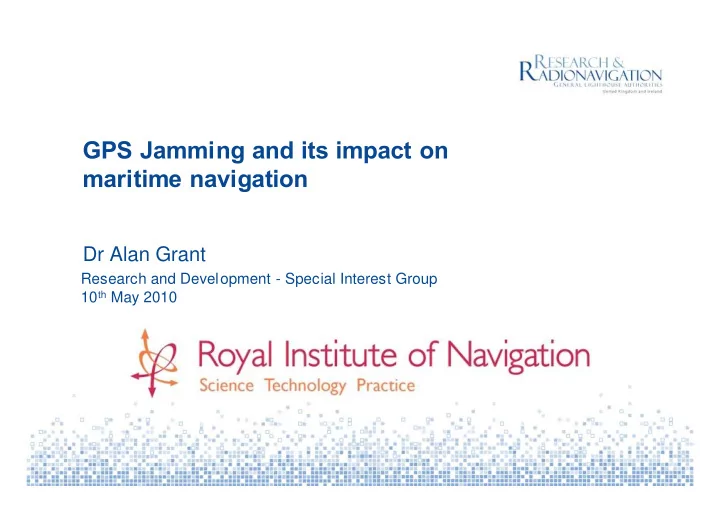

GPS Jamming and its impact on maritime navigation Dr Alan Grant Research and Development - Special Interest Group 10 th May 2010
Use of GPS in the maritime sector GPS has become the normal means for maritime positioning, navigation and timing. The level of integration onboard is different for each vessel depending on equipment fitted.
GPS Vulnerabilities Accidental Natural events GPS failures TV antenna Jamming unit left on accidentally GPS antenna hardware failure Intentional Arranged jamming trials Illegal use of jamming units Satellites orbit ~20,000km above the Earth
Pictures: www.redferret.net/?p=7864 Courtesy of Prof. David Last
GPS Jammer � GPS, Galileo & GLONASS bands Courtesy of Prof. David Last
� Satellite jamming equipment w as used to stop lorries being tracked after the y were stolen � Source: http://www.expressandstar.com/news/2010/05/06/6m-lorry-hijackings-gang-face-ten-years/
GLA GPS Jamming trials The GLAs have conducted two trials investigating the effects of GPS jamming. April 2008 off Flamborough Head Newcastle December 2009 off Newcastle Upon Tyne Upon Tyne Flamborough Head For both trials the jamming units were provided and operated by the Ministry of Defence through their Defence Science and Technology Laboratories (DSTL)
Flamborough Head trial Effect of GPS jamming on safe navigation Aids to Navigation (AtoN) � eLoran � Differential GPS � AIS as an AtoN On Ship � Navigation systems � Situational awareness On Shore � Vessel Traffic Management Coverage area of the GPS jamming unit at 25m above ground level on maximum power of 1.58W ERP . On People (Image courtesy of DSTL) � Safe navigation
eLoran Reported position from eLoran receiver operating in Reported position from eLoran receiver operating in Eurofix corrected GPS mode during control run with Calibrated eLoran mode with jamming enabled no jamming.
Differential GPS The GLAs operate 14 DGPS stations
Differential GPS
Synchronised Lights Synchronised lights simulating a port approach Lights use GPS as a common timing source
Ship systems Positions plotted using GPRMC Erroneous reported positions as NMEA data from run without jamming effect of jamming signal is observed. Colours indicate reported speed: blue <15knts, yellow< 50knts, orange <100knots and red >100knts
Ship systems GPS reported position is inland and 22km away from true position (eLoran). Colours indicate reported speed: blue <15knts, yellow< 50knts, orange <100knots and red >100knts
Effect on Ship & Shore The effect of GPS jamming on AIS was observed by: � NLV Pole Star � s AIS alarmed when GPS was lost. � Without GPS it could not provide a range or bearing to surrounding vessels or AtoNs. � Some AIS returns included erroneous positions.
Effect on Ship & Shore Image courtesy of the MCA
People NLV Pole Star � s crew were able to navigate safely during GPS outage. However, it should be noted: Vessel � � s crew had advance knowledge � Parallel indexing on Radar � Switched ECDIS screen off Severity of GPS denial depends on: � Ability of crew to use traditional means � Availability of traditional means During entry and exit of the jamming regi on system alarms sounded for around 5 mi nutes.
Flamborough Conclusions GPS jamming can severely affect the safety of the mariner GPS jamming resulted in: � Numerous alarms on the bridge � NLB Pole Star Erroneous GPS positions � Failure of GPS fed equipment � Erroneous information presented on the vessels ECDIS � Misleading information presented by the vessels AIS � Reduced situational awareness
Newcastle Demonstrations Demonstrations of the effect of GPS jamming on a typical vessel to encourage the development of resilient Position, Navigation and Timing information . Audience represented: � UK Government � European Governments � DGPS Service providers � Mariners � Industry � Press THV Galatea
Demonstration approach Two scenarios were demonstrated: Full signal denial The jamming signal is significantly greater than the GPS signal and prevents GPS reception Comparable signal The jamming signal is slowly increased to simulate a vessel steaming towards a jamming source.
Ship installation For the demonstrations additional equipment was installed on the demonstration vessel: A typical Electronic Chart Display amended to show two positions -A GPS position -A eLoran position
eLoran The Newcastle trial used eLoran with a reference s tation installed in South Shields. The reference station took under 24hrs to install, reference its position and resulted in an eLoran position accurate to <9m (95%) eLoran has different failure modes to GNSS and was used as the truth in the demons trations.
Observed effects
Observed GPS position errors Erroneous GPS positions were observed on both typical GPS receivers installed for the demonstration. Observers with their own handheld GPS receivers observed erroneous positions, with Ireland and Eastern Europe favourite destinations. Not always this marked, subtle errors, giving Hazardous Misleading Information were also observed
Observed effects on AIS AIS Display under normal conditions AIS Display under full jamming conditions
Source: http://www.shipais.com/
Reverting to traditional means RADAR Alarms at the loss of GPS Can be misleading if AIS is overlaid Gyrocompass Alarms at the loss of GPS Drift errors can occur over time
Conclusions GPS jamming whether by intentional or unintentional means significantly affects maritime navigation. GPS jamming can cause Hazardous and Misleading information The level of disruption is dependent on: � the make and model of the equipment installed on the vessel � the configuration of the equipment (i.e. inputs to the ECDIS) � the signal strength of the jamming signal eLoran was demonstrated as a complimentary navigation system to GNSS providing a position of <9m (95%) providing seamless navigation. The GLAs recommend the use of multiple means of navigation and support the development of resilient PNT.
Thank you Contact Informati on Dr. Alan Grant, Email: alan.grant@gla-rrnav.org, Phone: +44 (0)1255 245141
Recommend
More recommend